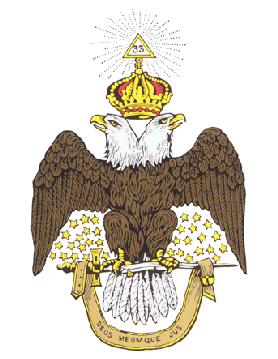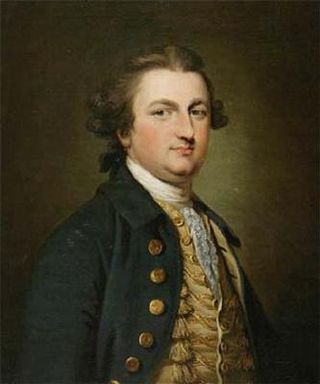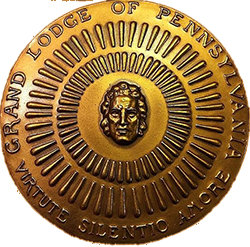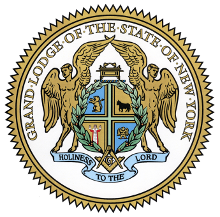
The Ancient and Accepted Scottish Rite of Freemasonry is a Rite within the broader context of Freemasonry. It is the most widely practiced Rite in the world, spanning from the Blue Lodge level, and is sometimes designated as a concordant body due to its relationship with the degrees of Symbolic (Craft) Freemasonry. In contrast to being an appendant body, the Scottish Rite operates as a complete Rite in itself. Its structure includes the first three degrees, administered by various Masonic organizations or bodies. Each such body is governed by its own central authority. In the Scottish Rite, the central authority consists of a Grand Lodge overseeing the 1st to 3rd degrees, and a Supreme Council overseeing the 4th to 33rd degrees. The Droit Humain is an exception, as it maintains a consistent central authority from the 1st to the 33rd degree.

A Masonic lodge, often termed a private lodge or constituent lodge, is the basic organisational unit of Freemasonry. It is also commonly used as a term for a building in which such a unit meets. Every new lodge must be warranted or chartered by a Grand Lodge, but is subject to its direction only in enforcing the published constitution of the jurisdiction. By exception the three surviving lodges that formed the world's first known grand lodge in London have the unique privilege to operate as time immemorial, i.e., without such warrant; only one other lodge operates without a warrant – the Grand Stewards' Lodge in London, although it is not also entitled to the "time immemorial" title. A Freemason is generally entitled to visit any lodge in any jurisdiction in amity with his own. In some jurisdictions this privilege is restricted to Master Masons. He is first usually required to check, and certify, the regularity of the relationship of the Lodge – and be able to satisfy that Lodge of his regularity of membership. Freemasons gather together as a Lodge to work the three basic Degrees of Entered Apprentice, Fellowcraft, and Master Mason.
The history of Freemasonry encompasses the origins, evolution and defining events of the fraternal organisation known as Freemasonry. It covers three phases. Firstly, the emergence of organised lodges of operative masons during the Middle Ages, then the admission of lay members as "accepted" or "speculative" masons, and finally the evolution of purely speculative lodges, and the emergence of Grand Lodges to govern them. The watershed in this process is generally taken to be the formation of the first Grand Lodge in London in 1717. The two difficulties facing historians are the paucity of written material, even down to the 19th century, and the misinformation generated by masons and non-masons alike from the earliest years.

Henry Somerset, 5th Duke of Beaufort was an English courtier and politician. He was the only son of Charles Noel Somerset, 4th Duke of Beaufort and Elizabeth Somerset, Duchess of Beaufort. Styled the Marquess of Worcester from 1746, at his father's death on 28 October 1756, he succeeded him as 5th Duke of Beaufort, 7th Marquess of Worcester, 11th Earl of Worcester, and 13th Baron Herbert.

Willie Jones was an American planter and statesman from Halifax County, North Carolina. He represented North Carolina as a delegate to the Continental Congress in 1780. His brother Allen Jones was also a delegate to the congress.

The Most Worshipful Grand Lodge of Ancient Free and Accepted Masons of the Commonwealth of Massachusetts, commonly referred to as the Grand Lodge of Massachusetts and abbreviated GLMA, is the main governing body of Freemasonry within Massachusetts, and maintains Lodges in other jurisdictions overseas, namely Panama, Chile, the People's Republic of China, and Guantanamo Bay Naval Base, Cuba.

The Royal Order of Scotland is an appendant order within the structures of Freemasonry. Membership is an honour extended to Freemasons by invitation. The Grand Lodge of the Royal Order of Scotland is headquartered in Edinburgh, with a total of 88 subordinate Provincial Grand Lodges; of these, the greatest concentration is in the British Isles, with the rest located in countries around the world.

The Grand Lodge of Pennsylvania, officially The Right Worshipful Grand Lodge of the Most Ancient and Honorable Fraternity of Free and Accepted Masons of Pennsylvania and Masonic Jurisdictions Thereunto Belonging, sometimes referred to as Freemasons of Pennsylvania is the premier masonic organization in the Commonwealth of Pennsylvania. The Grand Lodge claims to be the oldest in the United States, and the third oldest in the world after England and Ireland, having been originally established as the Provincial Grand Lodge of Pennsylvania in 1731. This claim is disputed by both the Grand Lodge of Massachusetts and the Grand Lodge of Virginia.
Freemasonry in Sweden was introduced by the Swedish Order of Freemasons, founded in 1735 as the oldest still active Swedish fraternal order, working the Swedish Rite of Freemasonry. It is under royal patronage of the King of Sweden and closely associated with the Lutheran Church of Sweden. It is a jurisdiction that admits Christian men only, and is recognised by the United Grand Lodge of England as a Regular Masonic jurisdiction, being the only Regular Grand Lodge that admits a 34th informal Masonic Degree. Its total membership is about 16,500.

The Grand Lodge of Ancient Free and Accepted Masons of Canada in the Province of Ontario is a Grand Lodge with jurisdiction over 571 masonic lodges located in the province of Ontario in Canada with around 46,000 members. The Grand Lodge is in full amity and recognition with the United Grand Lodge of England. The Grand Lodge publishes an annual magazine Ontario Mason.

The Ancient Grand Lodge of England, as it is known today, or The Grand Lodge of the Most Ancient and Honourable Fraternity of Free and Accepted Masons as they described themselves on their warrants, was a rival Grand Lodge to the Premier Grand Lodge of England. It existed from 1751 until 1813 when the United Grand Lodge of England was created from the two Grand Lodges. They are now called the Antients, in contrast to the Moderns, the original Grand Lodge which its critics, notably Laurence Dermott, said had moved away from the ritual of Scotland, Ireland, and now the Antient Grand Lodge. This Grand Lodge was also informally called the Atholl Grand Lodge because the Third and Fourth Dukes of Atholl presided over it as Grand Masters for half of its 62-year existence.

The organisation now known as the Premier Grand Lodge of England was founded on 24 June 1717 as the Grand Lodge of London and Westminster. Originally concerned with the practice of Freemasonry in London and Westminster, it soon became known as the Grand Lodge of England. Because it was the first Masonic Grand Lodge to be created, modern convention now calls it the Premier Grand Lodge of England in order to distinguish it from the Most Ancient and Honourable Society of Free and Accepted Masons according to the Old Constitutions, usually referred to as the Ancient Grand Lodge of England, and the Grand Lodge of All England Meeting at York. It existed until 1813, when it united with the Ancient Grand Lodge of England to create the United Grand Lodge of England.

This is a chronology of the formation of "regular" or "mainstream" Masonic Grand Lodges in North America, descending from the Premier Grand Lodge of England or its rival, the Antient Grand Lodge of England. A Grand Lodge is the governing body that supervises "Craft" Freemasonry in a particular jurisdiction or geographical area.

The Grand Lodge of New York is the largest and oldest independent organization of Freemasons in the U.S. state of New York. The headquarters of the Grand Lodge is the Grand Lodge Building located at 23rd Street in Manhattan.
Claude Joseph Sauthier (1736–1802) was an illustrator, draftsman, surveyor, and mapmaker. He was employed by the British colonial government in the American colonies prior to and during the American Revolutionary War.

William Palfrey (1741–1780) was an American Patriot.

Thomas Dunckerley was a prominent freemason, being appointed Provincial Grand Master of several provinces, promoting Royal Arch masonry, introducing Mark Masonry to England, and instituting a national body for Templar masonry. This was made possible by an annuity of £100, rising to £800, which he obtained from King George III by claiming to be his father's illegitimate half brother.
James Coor was an architect, builder, politician and leader in North Carolina.
The Grand Lodge of Ancient, Free and Accepted Masons of North Carolina, also known as the Grand Lodge of North Carolina, was founded 12 December 1787. Previously, it was the Provincial Grand Lodge of North Carolina, being under jurisdiction of the Premier Grand Lodge of England since 14 Jan 1771. It is currently composed of 360 active lodges across the 100 counties of North Carolina. The Grand Lodge recognizes its Prince Hall counterpart, The Most Worshipful Prince Hall Grand Lodge of North Carolina and its Jurisdictions, Inc., and maintains co-territorial jurisdiction and encourages visitation between the two entities.
Freemasonry in the United States is the history of Freemasonry as it was introduced from Britain and continues as a major secret society to the present day. It is a fraternal order that brings men together to gain friendship and opportunity for advancement and community progress. It has been nonpolitical except for a period around 1820 when it came under heavy attack in the Northeast. That attack reduced membership, but it recovered and grew after 1850. Growth ended in the late 20th century and membership has declined.















